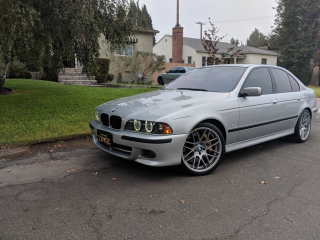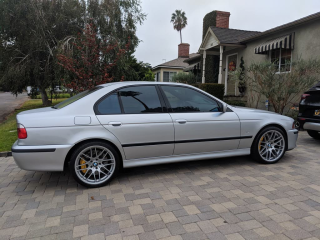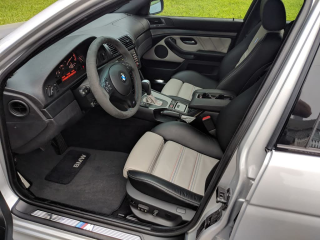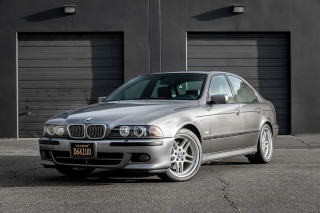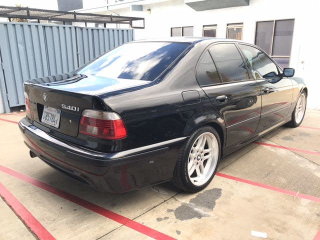The 2003 BMW 5 Series (E39 generation) is a mid-size luxury sedan known for its blend of sportiness and comfort. Produced from 1995-2003 (E39), the 2003 model represents the final year of this highly regarded generation. Key trims included the 525i, 530i, and 540i. It's popular for its balanced handling, refined interior, and powerful engine options. Original pricing ranged from around $35,000 to $55,000 depending on the trim and options.
The Good
The 2003 BMW 5 Series offers a compelling mix of performance and luxury. Its responsive handling and powerful engine options appeal to driving enthusiasts. The comfortable interior and refined ride make it suitable for daily commutes. While not the most fuel-efficient, it provides a solid value proposition in the used luxury car market. The timeless design still looks good today.
The Bad
Known weaknesses of the 2003 BMW 5 Series include potential issues with the cooling system (radiator, water pump, thermostat), suspension components (control arms, bushings), and electrical systems. Oil leaks can also be a concern. Thorough inspection and maintenance records are crucial before purchasing.
2003 BMW 5 Series: Quick Overview
- Engine Options:
- 525i: 2.5L Inline-6 (M54)
- 530i: 3.0L Inline-6 (M54)
- 540i: 4.4L V8 (M62)
- Horsepower:
- 525i: 184 hp
- 530i: 225 hp
- 540i: 290 hp
- Fuel Economy (EPA estimated):
- 525i: 20 mpg city / 29 mpg highway
- 530i: 19 mpg city / 27 mpg highway
- 540i: 15 mpg city / 22 mpg highway
- 0-60 Times (approximate):
- 525i: 8.1 seconds
- 530i: 6.8 seconds
- 540i: 6.2 seconds
- Towing Capacity: Not generally recommended for towing.
- Trim Level Features:
- 525i: Standard features include automatic climate control, power windows and locks, cruise control, premium sound system, alloy wheels, and leatherette upholstery.
- 530i: Adds to the 525i with features like upgraded leather upholstery, wood trim, and automatic headlights.
- 540i: Includes the 530i's features plus a more powerful V8 engine, sport suspension, and upgraded brakes.
2003 BMW 5 Series Specifications
Vehicle Information
| Year | 2003 |
| Make | BMW |
| Model | 5-Series |
| Trim | - |
| Style | 4-Door Sedan 6-Speed Manual |
| Type | Sedan |
| Category | - |
Manufacturing Details
| Made In | - |
| Manufacturing City | - |
Dimensions
| Doors | 4-Door |
| Curb Weight | - |
| Gross Vehicle Weight Rating | - |
| Overall Height | - |
| Overall Length | - |
| Overall Width | - |
| Wheelbase Length | - |
| Standard Seating | - |
Engine & Performance
| Engine | - |
| Engine Size | - |
| Engine Cylinders | - |
| Transmission | 6-Speed Manual |
| Transmission Type | Manual |
| Transmission Speeds | 6-Speed |
| Drivetrain | - |
Additional Features
| Anti-Brake System | - |
| Steering Type | - |
Pricing
| Manufacturer Suggested Retail Price (MSRP) | - |
| Invoice Price | - |
| Delivery Charges | - |
Vehicle History Report
Vehicle
Specifications
Specifications
Ownership
History
History
All History
Events
Events
NMVTIS Title
History Check
History Check
Salvage/Rebuilt
Check
Check
Accident
Check
Check
Theft
Check
Check
Open Lien
Check
Check
Past Sale
Listings
Listings
Safety
Recalls
Recalls
Odometer
Check
Check
Market Price
Analysis
Analysis
What Problems Does the 2003 BMW 5 Series Have?
Frequently reported problems for the 2003 BMW 5 Series (and the E39 generation in general) often revolve around cooling system failures. The radiator, water pump, and thermostat housing are prone to cracking and leaking, which can lead to overheating and engine damage if not addressed promptly. Suspension issues are also common, particularly with the control arms and bushings, resulting in a loose or unstable ride. Oil leaks, especially from the valve cover gasket and oil filter housing, are another recurring concern. Electrical problems can arise, including issues with the instrument cluster, window regulators, and various sensors. While there weren't any major recalls specific to the 2003 model year alone, it's important to check for any outstanding recalls related to previous years in the E39 generation. Long-term reliability depends heavily on maintenance. Neglecting cooling system maintenance, for instance, can lead to significant engine damage over time. The 540i, with its V8 engine, can be more expensive to maintain due to its increased complexity and potential for higher oil consumption. Regular inspections and proactive repairs are essential for keeping a 2003 BMW 5 Series running reliably.
How long will the 2003 BMW 5 Series last?
A well-maintained 2003 BMW 5 Series can easily exceed 200,000 miles and provide many years of service. However, longevity heavily depends on consistent maintenance. Neglecting common issues like cooling system problems or oil leaks will drastically shorten its lifespan. With proper care, these cars can last upwards of 20 years. Long-term durability weaknesses often revolve around the aforementioned cooling system and suspension components. Rust can also become a concern, particularly in regions with harsh winters. Regular fluid changes and addressing issues promptly are crucial for maximizing the car's lifespan and preventing major repairs.
What Technology & Safety Features are Included?
The 2003 BMW 5 Series offered a decent array of tech and safety features for its time. Standard features included anti-lock brakes (ABS), traction control, and multiple airbags (front, side). The entertainment system typically consisted of a premium sound system with a CD player. Higher trims and optional packages could add features like a navigation system (using a screen in the center console), a sunroof, and upgraded audio components.
Driver-assistance features were limited compared to modern vehicles, but cruise control was standard. Some models may have included parking sensors as an option.
Safety features were a strong point, with BMW emphasizing structural integrity and active safety systems. Crash test ratings from the Insurance Institute for Highway Safety (IIHS) and the National Highway Traffic Safety Administration (NHTSA) were generally good for the E39 5 Series. However, it's important to remember that safety standards and technologies have significantly advanced since 2003. Optional features varied depending on the trim level and packages selected. These could include a sport suspension, upgraded wheels, heated seats, and a premium leather interior. The technology, while advanced for its time, is now dated compared to modern vehicles. Features like Bluetooth connectivity and smartphone integration were not standard and may have been available only as aftermarket additions.
Driver-assistance features were limited compared to modern vehicles, but cruise control was standard. Some models may have included parking sensors as an option.
Safety features were a strong point, with BMW emphasizing structural integrity and active safety systems. Crash test ratings from the Insurance Institute for Highway Safety (IIHS) and the National Highway Traffic Safety Administration (NHTSA) were generally good for the E39 5 Series. However, it's important to remember that safety standards and technologies have significantly advanced since 2003. Optional features varied depending on the trim level and packages selected. These could include a sport suspension, upgraded wheels, heated seats, and a premium leather interior. The technology, while advanced for its time, is now dated compared to modern vehicles. Features like Bluetooth connectivity and smartphone integration were not standard and may have been available only as aftermarket additions.
What Colors Options are Available?
Exterior Colors
Alpine White
Black Sapphire Metallic
Silver Gray Metallic
Orient Blue Metallic
Titanium Silver Metallic
Oxford Green Metallic
Steel Blue Metallic
Imola Red
Electric Red
Interior Colors
Sand Beige
Gray
Black
Natural Brown
2003 BMW 5 Series Prices and Market Value
When new, the 2003 BMW 5 Series ranged from approximately $35,000 to $55,000, depending on the trim and options. Currently, used market prices typically range from $3,000 to $10,000 or more, depending on condition, mileage, and location. Depreciation has been significant, as is typical for luxury vehicles. Factors affecting resale value include: mileage, condition (both mechanical and cosmetic), maintenance records, and the specific trim level. Cars with extensive service history and minimal wear and tear command higher prices. The 540i, with its V8 engine, might hold slightly more value for enthusiasts.
2003 BMW 5 Series Cost of Ownership
The 2003 BMW 5 Series is generally considered costly to own compared to mainstream vehicles. Insurance premiums can be higher due to its luxury status and potential repair costs. Fuel economy is average at best, especially with the V8 engine. Maintenance and repair costs can be significant, as parts and labor are typically more expensive for BMWs. Addressing potential issues proactively is crucial to preventing major expenses. While not economical, the driving experience and luxury features may justify the cost for some buyers.
2003 BMW 5 Series Fuel Efficiency
Fuel Type
-
Fuel Capacity
-
City Mileage
-
Highway Mileage
-
2003 BMW 5 Series Safety Rating
NHTSA
2003 BMW 5 Series Insurance
Insurance for a 2003 BMW 5 Series is moderately priced, reflecting its status as a Sedan with strong safety ratings and
reasonable repair costs.
reasonable repair costs.
How Does the 2003 BMW 5 Series Compare to Other Sedan?
The 2003 BMW 5 Series competed with the Mercedes-Benz E-Class (W211), Audi A6 (C5), and Lexus GS. In terms of performance, the BMW generally offered a sportier driving experience than the Mercedes or Lexus. The Audi A6 provided a similar level of performance with available quattro all-wheel drive. Features were comparable across these models, although specific options varied. Reliability is where the BMW lags somewhat behind the Lexus GS, which is known for its exceptional dependability. The Mercedes E-Class and Audi A6 also had their share of reliability concerns. Price-wise, the BMW was generally competitive with its rivals.
Alternatives to the 2003 BMW 5 Series include:
* **Lexus GS:** For buyers prioritizing reliability above all else.
* **Mercedes-Benz E-Class:** For a more comfort-oriented luxury experience.
* **Audi A6:** For a blend of performance, luxury, and available all-wheel drive.
Whether one of these is "better" depends on individual priorities. If a sporty driving experience is paramount, the BMW remains a strong choice. However, buyers concerned about long-term reliability might consider the Lexus GS.
Alternatives to the 2003 BMW 5 Series include:
* **Lexus GS:** For buyers prioritizing reliability above all else.
* **Mercedes-Benz E-Class:** For a more comfort-oriented luxury experience.
* **Audi A6:** For a blend of performance, luxury, and available all-wheel drive.
Whether one of these is "better" depends on individual priorities. If a sporty driving experience is paramount, the BMW remains a strong choice. However, buyers concerned about long-term reliability might consider the Lexus GS.
Ranks #749 Sedan
| 1 | 2023 Toyota Camry | (5.0★) |
| 2 | 2023 Honda Accord | (0.0★) |
| 3 | 2023 Lexus ES | (0.0★) |
| 4 | 2024 Subaru Legacy | (5.0★) |
| 5 | 2022 Mazda MX-30 | (4.0★) |
| 6 | 2024 BMW M3 | (0.0★) |
| 7 | 2023 Ford Mustang | (5.0★) |
| 8 | 2023 Mercedes-Benz AMG GT | (0.0★) |
| 9 | 2023 Audi A3 | (0.0★) |
| 10 | 2023 Chevrolet Camaro | (5.0★) |
| 11 | 2023 Hyundai Elantra Hybrid | (0.0★) |
| 12 | 2023 Nissan Altima | (4.0★) |
| 749 | 2003 BMW 5 Series | (0.0★) |
Final Verdict: Is the 2003 BMW 5 Series a Good Sedan?
The 2003 BMW 5 Series is ideal for driving enthusiasts who appreciate a balanced blend of sportiness and luxury, and are willing to accept potentially higher maintenance costs. Whether it's worth buying depends on the individual car's condition and service history. A well-maintained example can provide a rewarding driving experience. It's best to buy used, as new models are no longer available. Opting for a lower-mileage example with complete service records is highly recommended. The 530i offers a good balance of performance and fuel economy. Be prepared for potential repairs and budget accordingly. Thorough inspection before purchase is crucial.
